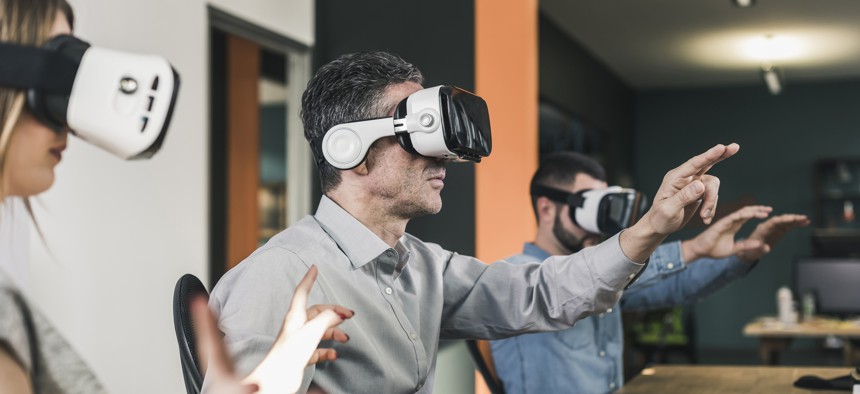What’s next in government tech

Westend61/Getty Images
Blockchain, artificial intelligence and augmented and virtual reality offer agencies new opportunities, but modernizing legacy infrastructure will be key, a recent report says.
Governments face plenty of challenges and opportunities in 2023, with both emerging technologies and existing infrastructure sure to be high on the agenda. Meanwhile, new skills are needed for the latest advances, but agency tech talent is being decimated by retirements and competition from the private sector.
That is all according to Deloitte’s Government Tech Trends forecast, an annual look at the coming year designed to help government leaders “be a little more curious about the future.” The report gives executives “a little time stepping outside themselves and stepping outside of the firefighting,” said Scott Buchholz, chief technology officer for Deloitte’s Government and Public Service practice.
Opportunities with emerging tech
In 2023 governments should consider taking advantage of emerging technologies like blockchain and artificial intelligence, as well as augmented and virtual reality, the report said.
With AR and VR, governments can provide a place for constituents to engage with staff virtually for specific assistance. The technology could make interactions with government agencies more widely available to residents with disabilities or to those who don’t have adequate time or transportation options. VR could also be useful for immersive training for agency staff, such as inspectors, social workers and law enforcement, Deloitte said, preparing them for real world scenarios.
The report also called for governments to embrace AI, but it cautioned agencies to carefully think through its implementation and avoid replicating bad business practices at scale. AI should be considered as a “wise, experienced colleague” that could support automation and help ease customer interactions, the report said.
Deloitte expressed optimism about using blockchain to “automate and reengineer” processes and distribute digital trust. While some states are in the early stages of capitalizing on the technology, Deloitte said it provides an opportunity reengineer and automate processes with organizations both inside and outside of government
While governments may be excited about unleashing emerging technologies, Buchholz warned that leaders should first focus on the problems their constituents want solved, then work backwards to determine whether a technology solution is best. He said it is crucial to avoid what tech professionals are sometimes guilty of, which is finding “a really cool hammer, and then go around looking for a nail.”
Cloud, legacy infrastructure modernization
While emerging technologies present dizzying opportunities for governments, the report also urged them to modernize their existing infrastructure, including thinking more carefully about how to manage their cloud practices.
The report recommended governments use commercial off-the-shelf tools to help manage details like security and data privacy across all their cloud vendors and find ways to automate the management of complex tasks. By doing so, skilled staff will be freed up to work on other projects.
Meanwhile, Deloitte also urged governments to update their functional, core, legacy infrastructure assets with new technologies, such as AI-powered middleware, advanced microservices and refreshed user interfaces. Allowing for “more progressive modernization” can enable incremental improvements to service and reduce the risk of data loss during migration. While infrastructure modernization may not have been a big priority in previous years, Buchholz said it’s time to take advantage of how supporting technologies have matured.
“Many organizations look at modernization every five to 10 years,” he said. “If people haven't looked recently, they should probably look again because there are increasingly sophisticated and increasingly capable ways of eating the elephant, of chunking up the problem to make it more straightforward.”
A reimagined tech workforce
As uncertainty continues to roil the job market, state and local governments could become “even more attractive” to prospective employees, the Deloitte report said. But the company urged governments not just to act quickly to recruit top talent, but also consider attracting what it called “non-traditional talent.” Workers with experience in fields as diverse as climate, robotics and energy technologies can help agency tech managers expand from enterprise IT to “xTech,” or the extended set of technologies.
Act now for ‘the best of the future’
While governments at all levels have a long way to go before adopting new technologies and modernizing their existing ones, the report called on officials to act quickly to secure funding, policy and research to embrace new opportunities. That could be in areas like space technology or the future of cells and biology, Deloitte said, but it cannot happen without governments acting to “make sure the future is better and brighter than today.”
2023 can be a successful year for governments if they work to upgrade their tech talent and address legacy systems that “constrained” them from making change in the past, Buchholz said. Engaging with “some of the best ideas from the outside” can help make these new technological opportunities successful, he said. It can help government get the “best of the future.”






